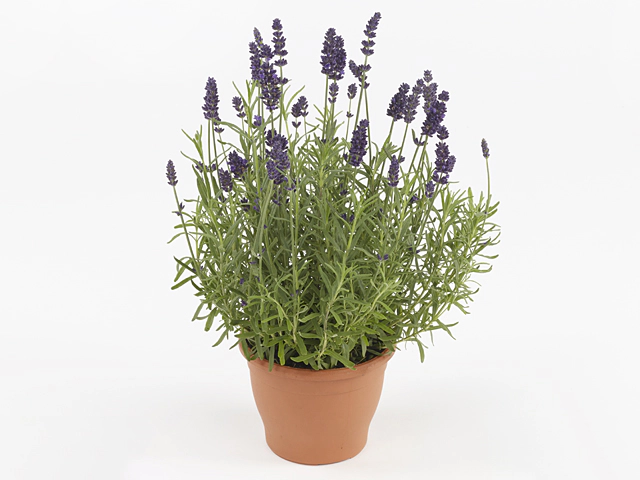Lavandula angustifolia Valence Deep Violet

| Leaf arrangement | crosswise opposite |
| Flower scent | Sweet scented |
| Winter hardness | Limited (USDA-zone 8) |
| Flower color | Purple-dark blue violet-N088A |
| Leaf, general shape | Linear |
| Leaf, scent | Pleasantly scented |
| Flower diameter | Small; 1 - 10 mm |
| Plant height | 20 - 30 cm |
| Inflorescence | Spike |
| Flowering month(s) | June; July; August |
| Leaf size | 3 - 4 cm |
| Inflorescence length | <5 cm |
| Inflorescence diameter | 1 - 2 cm |
| Flower color distribution | Unicolored |
Lavender, scientifically known as Lavandula angustifolia Valence Deep Violet, is a beautiful plant known for its sweet scent and striking purple-dark blue violet flowers. With its crosswise opposite leaf arrangement and linear shape, lavender adds elegance and charm to any garden or landscape.
Although lavender is beloved for its fragrance, it also possesses pleasant-scented leaves, contributing to its overall appeal. The plant reaches a height of 20-30 cm, making it ideal for borders, containers, or as a low-growing groundcover. Its small, 1-10 mm diameter flowers are clustered in spikes, creating a stunning inflorescence that typically measures less than 5 cm in length and 1-2 cm in diameter.
Lavender blooms during the summer months, specifically in June, July, and August, filling the air with its sweet perfume. Despite its captivating qualities, lavender is only moderately winter hardy and is typically limited to USDA-zone 8. Therefore, it requires some protection and care to thrive in colder climates.
The lavender plant also features compact leaves that measure around 3-4 cm, further enhancing its overall aesthetic appeal. The flower color distribution is unicolored, with deep violet hues dominating the blossoms.
Aside from its visual and olfactory appeal, lavender is also valued for its various uses. Its essential oil is widely used in aromatherapy, known for its calming and soothing effects. The dried flowers can be used to make potpourri, sachets, or added to culinary recipes for a delicate floral flavor.
In the garden, lavender attracts pollinators like bees and butterflies, making it a great choice for supporting local pollinator populations. The plant is also relatively low-maintenance, requiring well-drained soil, plenty of sunlight, and occasional pruning to promote healthy growth.
Whether you're looking to add a touch of beauty to your garden, enjoy its sweet scent, or reap the benefits of its essential oil, Lavandula angustifolia Valence Deep Violet is a fantastic choice. With its compact size, stunning deep violet flowers, and pleasant fragrance, this lavender variety is sure to create a serene and enchanting atmosphere wherever it's planted.
Market availability index by month:
| Jan. | Feb. | Mar. | Apr. | May | Jun. | Jul. | Aug. | Sep. | Oct. | Nov. | Dec. |
|---|---|---|---|---|---|---|---|---|---|---|---|
| 1 | 1 | 2 | 3 | 4 | 3 | 3 | 2 | 1 | 1 | 1 | 1 |